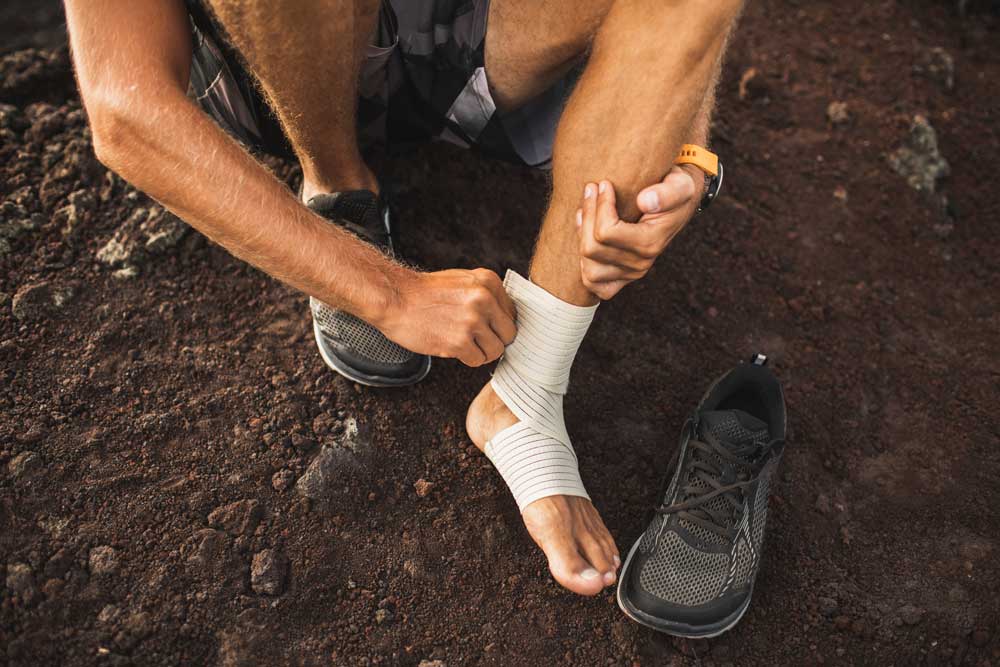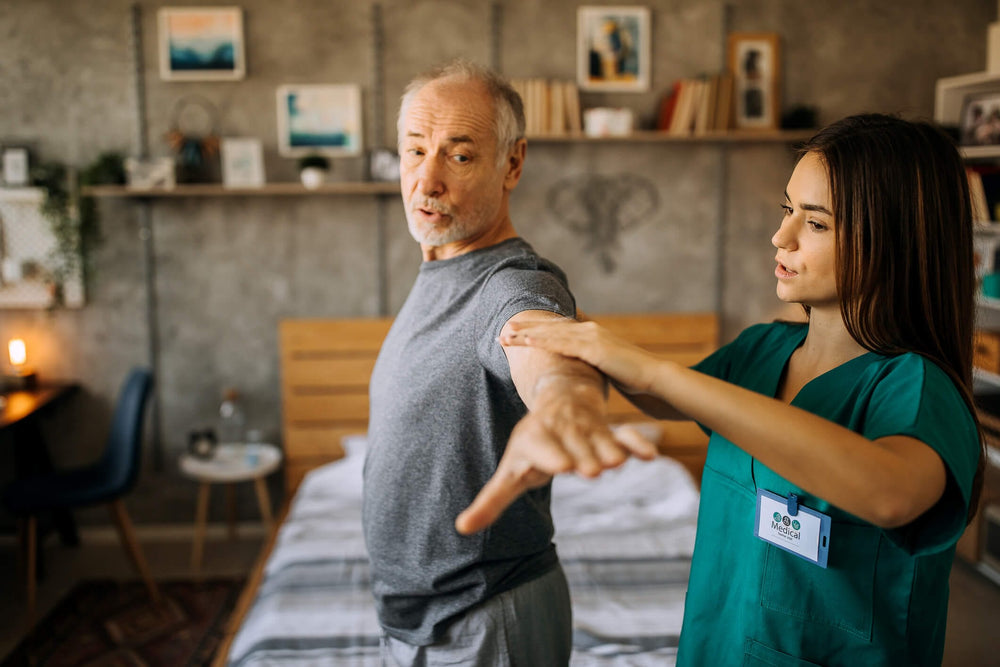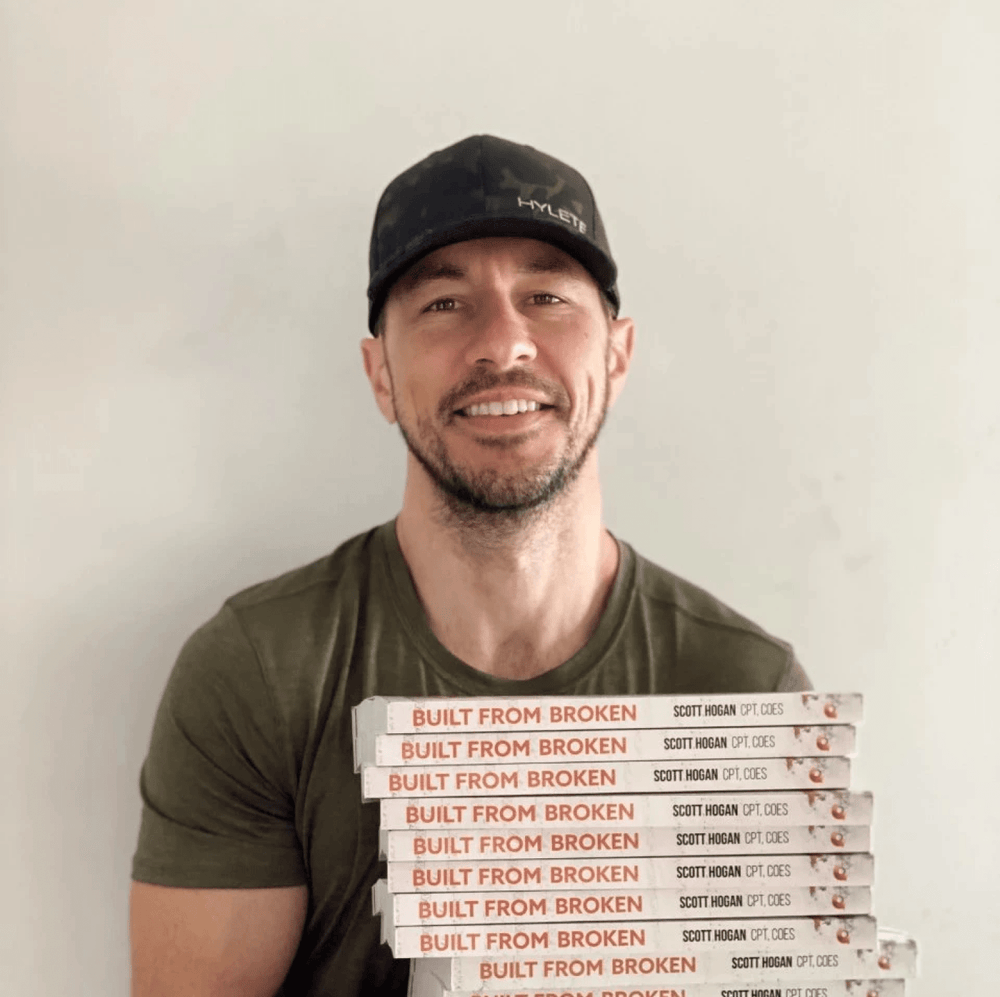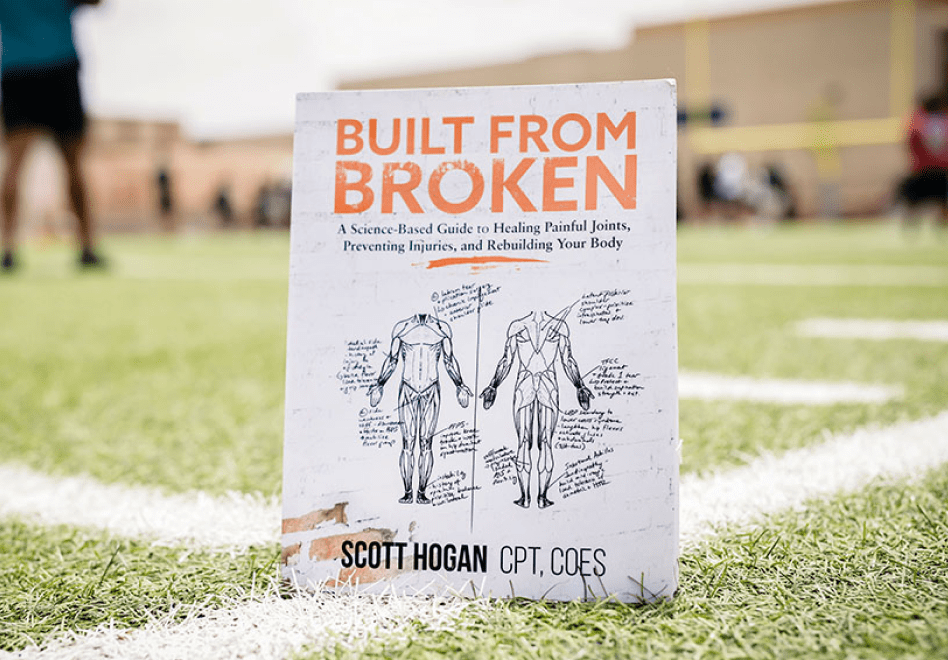
Be built (to last).
The right supplements can help you recover naturally and build a resilient body.

Supplement Quiz
Take this short quiz to discover the perfect supplements for your needs and goals.
About SaltWrap

Built from Broken
Get the best-selling book from SaltWrap founder, Scott Hogan, and start rebuilding today.
Our Philosophy
by Scott Hogan, ACE-CPT, COES
The mainstream image of fitness is doing exercises you hate and eating food that tastes like crap to impress people you probably don’t even like. This line of thinking leaves people disappointed, jaded, and injured.
It’s all backwards.
You shouldn't have to choose between optimizing performance (now) and your health (later).
Fitness should be about health first, function second, and all the other stuff third. Or not at all.
And the supplement industry has its fair share of black eyes… From protein-spiking to false labeling to banned substances sneaking into formulations...
So where do we fit in all this?
Hopefully, as a voice of reason in the midst of chaos.
A balanced, well-researched, and experienced voice of reason — aimed at helping you overcome obstacles, prevent pain and injuries, and achieve your potential.
We're here to bridge the gap between fitness and longevity.
Where do our recommendations come from?
All of our recommendations and products are based off of three fundamental concepts to ensure safety, efficacy, and practicality:
- Peer-Reviewed Research for Safety and Efficacy
- History of Traditional Use
- Clinical Experience (what we've seen work in the real world)

Athletic trainers have always impressed me.
It’s a really interesting job if you think about it.
Their main job is to help athletes work through injuries and get back on the playing field.
But at the same time, they’re responsible for long term health outcomes.
An eager coach might rush an injured athlete through a recovery process to get him back on the field. But a good trainer looks out for the athlete. That’s their main priority — not just winning.
And unlike most doctors who tell you to stop doing anything that hurts, a trainer will push you.
They're not content with you sitting on the sidelines.
It’s a balancing act.
Focused on performance and “winning,” but also on longevity. Looking at the big picture.
I saw this first-hand during my high school and college baseball career. I probably spent as much time in the training room as I did on the field.
I sat in ice baths. Was hooked up to EMS (Electrical Muscle Stimulation) machines. And went through the painful PNF stretching process to get my mobility back after shoulder surgery.
(Believe it or not, one of the trainers I worked with was also my dad’s trainer when he played baseball at the same school. He went by “Doc.” And had a knack for quickly fixing athletes with a hands-on, no bullshit [no cry babies] approach.)
This is the role I want SaltWrap to play.
We aren’t just focused on performance and helping you look good naked. Those things are nice and all, but I’m more interested in what you’ll be able to accomplish next year. Or in 10 years. Or what your joint health and overall function looks like in 20 years.
The mainstream image of “fitness” is doing exercises you hate and eating food that tastes like crap to impress people you probably don’t even like. This line of thinking leaves people disappointed, jaded, and injured.
It’s all backwards.
Fitness should be about health first, function second, and all the other stuff third (or not at all).
There's far too much short-sighted thinking going on.
And far too many short-sighted products that may help you today, but screw you over tomorrow.
Instead, we look at the big picture. The whole picture.
This is the core of our mission.
We want to be your most trusted adviser for healing injuries, staying healthy, improving performance, and getting the most out of your body and mind — not just today, but for the long haul.
It’s this therapeutic lens that guides our every move.
That’s the “why” of our philosophy.
The “how” is evidence-based, therapeutic sports nutrition products.
And like all things good, the term “evidence-based” has been twisted into a phony marketing buzzword.
Here’s what evidence-based actually means.
Why it’s important.
And why so few companies follow through with this important principle.
True Evidence-Based Sports Nutrition
“Evidence based” has become just another marketing term.
Companies who’ve been caught selling expensive sugar powders disguised as protein supplements are now claiming to use “clinically-supported” doses in their products.
Throwing ingredients into a blend because a study referenced that dosage isn’t just lazy, it’s negligent.
To give you an example — caffeine is often cited as "clinically effective" for performance enhancement at 350-400 mg per day. Or, up to 6 mg/kg.
That's a lot. For most people, it's overkill.
It's dangerously close to the daily Tolerable Upper Limit. And the negative side effects and crash that follow negate many of the benefits (e.g. depletion of phosphocreatine levels).
A more moderate dosage of ~3mg/kg still accomplishes the main ergogenic goals without crashing your adrenal system.
These studies often use doses far beyond what is practical.
And depending on how the study is organized, it may not even be safe to take that dose for an extended period of time.
Not to mention potential interactions that could pop up when the ingredient is combined with other compounds.
Plus, research studies are only 100% reliable under the same conditions used in the experiment. Without the exact same context, you can’t be sure that the results are repeatable.
So no, it’s not good enough just to cite a study and call your ingredient “clinically-supported” or “evidence-based.”
Though our formulas are always grounded in proven ingredients (both in form, dosage and context), we use what I call the Triad of Proof.
Ingredients that fall under all three of these categories are certifiably ‘legit’ — to use a technical term.
I was first introduced to this concept of multi-faceted evidence by Dr. John Berardi, founder of Precision Nutrition. He’s one of the few highly educated fitness thought leaders that practices what he preaches. This is what walking the walk looks like.
In Dr. Berardi’s own words,
Evidence-based IS NOT:
only using stuff that is proven by research.
(This is how most people mistakenly use the term).
Evidence-based IS:
The intersection of clinical expertise (based on anecdotal evidence and the clinical best practices generated from it), patient preferences, and the best available scientific evidence (published, peer-reviewed research).
Bottom line, evidence-based doesn’t mean “I read it in a study on Pubmed.com.”
This ideology doesn’t leave any room for observing what is working in the real world, for real people, and adjusting accordingly.
Evidence-based means combining peer-reviewed research with clinical expertise (actually WORKING with clients) and what is practical and useful for the patient.
The inconvenient truth for marketing opportunists is that there is no such thing as “Evidence Based” without real-world experience. Sorry guys.
Instead, here’s the test we use to determine if an ingredient or protocol passes muster:
The Triad of Proof
1. Peer-Reviewed Research for Safety and Efficacy
Nothing is more important than proving an ingredient is safe. This goes beyond merely using ingredients that are “Generally Recognized as Safe” (GRAS) by the FDA. There needs to be peer-reviewed studies concluding that the ingredient is safe for regular use, and in combination with the other ingredients in the blend. Further, the studies used to support any claims of safety and efficacy should be performed on the same compound, application method, and dosage.
For example, just because studies show that injecting hyaluronic acid improves joint pain doesn’t mean that eating the stuff will work. Or that it’s safe. In the case of hyaluronic acid, it happens to be both safe and effective as an injectable and an oral supplement for knee osteoarthritis.
And, for a protocol to be deemed effective, there needs to be more than one study showing a positive result. It should be a repeatable outcome.
We use this research-backed approach as the foundation for all our formulas.
Classification of Scientific Evidence
Not all scientific evidence is created equally:
-
BEST: Systematic reviews, meta-studies, and randomized peer-reviewed controlled trials with repeated outcomes
-
BETTER: High quality diagnostic studies without randomization or blinding, or that do not have definitive repeated outcomes compared
-
GOOD: Case studies and retrospective analysis studies
-
JUST OK: Observational studies without control group
-
INADEQUATE: Opinions shared based on experience without scientific support
Inspired by the EMB Manifesto at the Center for Evidence-Based Medicine.
Our products are grounded in legitimate, peer-reviewed studies.
Some companies have stepped up their game on this front, using higher doses of ingredients that more closely approximate what has been proven to be effective in studies.
But that’s not enough. In fact, it’s negligent when applied blindly. More on that in a second.
Not only is this process hard work — poring through dense scientific literature — it’s expensive. And, the clinically-supported dose is often too large to fit into 3 or 4 average sized (“00”) capsules.
This makes the formulation process challenging, and for many business models, it’s not feasible because it cuts too far into their profits.
Our challenge — and what I believe we’re good at it — is finding ingredients that we can use at clinically-supported levels, which are also cost effective for the end consumer, and potent enough to fit into a practical serving size and medium.
This is where the use of Minimal Effective Dosing (MED) comes in.
MED is a core concept of pharmacology, made popular by Tim Ferriss’s 4 Hour Body.
In medicine, using the MED is not just necessary for preventing waste — because taking more of something doesn’t always lead to more benefits — it’s a safety measure.
It improves health outcomes and decreases chances of negative side effects.
Our formulas are grounded in science and assembled as efficiently as possible to produce effects without waste, and without side effects.
2. History of Traditional Use
For over 2,000 years people have been using the adaptogenic herb Ashwagandha to increase energy, reduce stress, and improve overall health.
Long before dozens of clinical studies confirmed its therapeutic power as a healing herb, practitioners of the traditional Hindu system of medicine, Ayurveda, revered Ashwagandha as the most powerful and scared herb.
The absolute apex of natural healing herbs.
For most of Ayurvedic history, it’s been used as a “rasayana.”
Which means a holistic treatment for reducing emotional tension and relieving physical discomfort.
Today, we know that Ashwagandha:
-
Helps promote a healthy response to everyday stress, over-work and fatigue*
-
Helps support normal levels of mental clarity, concentration and alertness*
-
Helps support normal levels of vigor and performance*
-
Helps enhance sports performance*
Now, imagine if we would have waited until the 20th century to start using this powerful herb?
I’m not advocating consuming unproven, untested compounds.
The point is that there is wisdom in these old stories. In these types of traditions.
And while it should not be the stand-alone backing for any supplement, it deserves some serious respect.
Glandular supplements like grass-fed beef liver are another good example. While peer-reviewed research is lacking, both in quantity and in specificity of dosage, we've been consuming organ meats since cavemen were building fires. Our ancestors understood that organ meats provided superior nutrition value (and medicinal value) over every food source at their disposal.
We now know that organ meats are rich sources of B-vitamins, minerals, and other beneficial nutrients like CoQ10.
Without appreciating and understanding traditional use history, we'd miss out nature's most potent superfood.
When an ingredient or protocol has solid traditional use history, is proven to be safe and effective by peer-reviewed studies, AND has demonstrated effectiveness in a clinical setting (real world experience) — THEN it passes our litmus test.
That brings me to the third component of our Triad of Proof.
3. Clinical Experience
Though this term is often butchered... According to the Department of Health, clinical effectiveness is defined as:
"the application of the best knowledge, derived from research, clinical experience, and patient preferences to achieve optimum processes and outcomes of care for patients. The process involves a framework of informing, changing, and monitoring practice." (Department of Health, 1996)
The clinical experience component is what has been observed in real life.
For us, this means we’ve seen positive outcomes with our clients. And usually tested it ourselves.
Here’s why that’s so important: many research findings don’t translate into the real world.
Scientific studies are limited to the context and constraints of the study.
It’s not uncommon for a nutrient to show “statistically significant” outcomes in a study but do absolutely nothing when people consume the nutrient in the real world.
The opposite is true as well. When we find anecdotal evidence of something working (meaning it worked for an individual), we pay close attention.
Real World Applications
We discussed this concept in our injury guide. Just because a study demonstrated some outcome doesn't mean that outcome can be broadly applied to all scenarios. Example: one study showed that NSAID usage among older men improved exercise outcomes (in the short-term). Does this mean NSAIDs should be used to bolster exercise efforts? Definitely not.
Before anything is proven in a scientific study or assembled into a massive pile of data, it presents itself as small bursts of anecdotes.
Jeff Bezos, founder of Amazon.com, uses the same line of thinking to make decisions about how the company operates.
"I've noticed when the anecdotes and the metrics disagree, the anecdotes are usually right," he explained. "That's why it's so important to check that data with your intuition and instincts."
Anecdotal evidence is the tip of the spear when it comes to evidence-based practices.
And nothing beats real-world experience.
What’s working in the field. With real clients, right in front of us.
Especially when scientific literature and traditional use history are in alignment.
That right there is the ticket...
A grounding in legitimate peer-reviewed research, but ALSO proof of efficacy in the real world.
Research, traditional use, and real-world clinical experience...
When an ingredient or protocol passes all three of these conditions, it has our seal of approval.
Everything we do is supported by these three concepts: peer-reviewed research, traditional use, and clinical experience.
There is no substitute for the hard, time-consuming work of Research & Development.
And, it takes both critical thinking, intuition, and being responsive to client needs in order to help people succeed in this field.
Tossing ingredients into a formula because one study showed a positive effect isn't just lazy. It's negligent. We thoroughly vet everything we put together. Long before it's available to the public.
As far as product goals, we have four areas of focus:
Primary Product Goals
1. Treat the Athlete, Not the Injury
All of our sports nutrition products and recommendations consider the entire person. Not just the injured body part of specific ailment we are observing at the moment.
2. Therapeutic Sports Nutrition
When we say therapeutic sports nutrition, we mean supplements and interventions that have a healing effect while also supporting standard performance goals. We find the constraints holding athletes back, then infuse proven therapeutic protocols into existing nutrition, fitness, and supplement interventions.
3. Longevity of Outcomes
Our products are long-term focused; designed to help you move sustainably toward a state of peak health. No quick fixes here.
4. Practical Application
Practicality is the most underrated aspect of health behavior improvement. We work to seamlessly integrate our products and solutions into our clients’ daily routines.
The Bottom Line
We stand behind the quality of our products and the processes we've put in place to create safe, effective therapeutic sports nutrition supplements.
And we back it up with an unparalleled "Love-It-Or-Free" Guarantee.
To view our newest and most popular products, visit our All Products page here.
Founder: Scott Hogan

I created SaltWrap to bring together the most practical ideas in therapeutic sports nutrition, corrective exercise, and functional fitness — with the goal of keeping you (and myself) strong, mobile, and built to last.
I've worked as an A.C.E. Certified Personal Trainer, Orthopedic Exercise Specialist, and nutritional supplement formulator.
But more importantly — I've spent most of my life battling injuries, joint pain, and just being plain beat up. So I know what it's like to struggle toward fitness goals.
SaltWrap is here to push you through injuries, setbacks and perceived physical limitations. To a place beyond what you think you're capable of. Sign up here to stay in the loop.
Learn more about my best-selling injury prevention and recovery book, Built from Broken.







